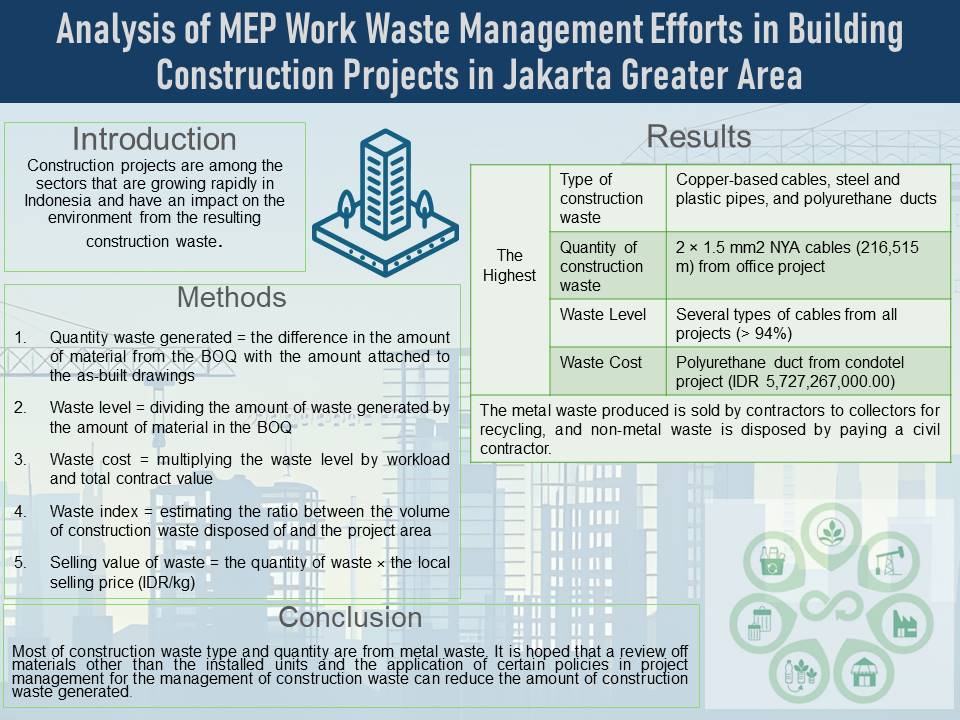Analysis of MEP Work Waste Management Efforts in Building Construction Projects in Jakarta Greater Area
Abstract
Construction projects are among the sectors that are growing rapidly in Indonesia and have an impact on the environment from the resulting construction waste. The purpose of this study is to analyze the highest type and quantity of construction waste generated from Mechanical Electrical Plumbing (MEP) work from the difference in the amount of material from the BOQ with the amount attached to the as-built drawings, evaluate the economic value by calculating the ratio of the amount of waste generated to the amount of material at BOQ (waste level) × the scope of work percentage (waste cost), selling value of waste (the quantity of waste × the local selling price), and costs of disposal of construction waste based on the agreement of each project management. This study uses a descriptive quantitative method. The results showed that most of the construction waste generated was based on its type, consisting of copper-based cables, steel and plastic pipes, and polyurethane ducts. The highest quantity of construction waste came from the office project, which was 2 × 1.5 mm2 NYA cables (216,515 m). The highest waste level value came from office, condotel, and factory projects using several types of cables (> 94%). The highest waste cost value came from
the condotel project is polyurethane duct (IDR 5,727,267,000.00). The metal waste produced is sold by contractors to collectors for recycling. Non-metal waste is disposed by paying a civil contractor. Construction waste management policies must be implemented to reduce the amount and impact of construction waste generated.
References
[BRANZ] Building Research Association of New Zealand. 2002. Easy Guide to Reducing Construction Waste.
[EPA] U.S. Environmental Protection Agency. 2008. Municipal Solid Waste Generation, Recycling, and Disposal in the United States. [Accessed 2020 Oct 22] Available from : https://archive.epa.gov/epawaste/nonhaz/municipal/web/pdf/msw2008data.pdf.
[EPA] U.S. Environmental Protection Agency. 2009. Estimating 2003 Building-Related Construction dan Demolition Material Amounts. [Accessed 2020 Oct 22] Available from : https://archive.epa.gov/region9/buildingreuse/web/pdf/cd-meas.pdf
[KemenPUPR] Kementerian Pekerjaan Umum dan Perumahan Rakyat . 2015. Peraturan Menteri Nomor 05/PRT/M/2015 tentang Pedoman Umum Implementasi Konstruksi Berkelanjutan Pada Penyelenggaraan Infrastruktur Bidang Pekerjaan Umum dan Permukiman. Jakarta (ID) : KemenPUPR.
[USGBC] U.S. Green Building Council . 2006, c2007. Green Building Research Funding: An Assessment of Current Activity in the United States. Mark Ginsberg Sustainability Fellow U.S. Green Building Council. [Accessed 2020 Oct 22] Available from: https://s3.amazonaws.com/legacy.usgbc.org/usgbc/docs/Archive/General/Docs2465.pdf.
Dewi L, Hanik U, Habibah A, Candra. 2021. Determinan Harga dan Potensi Sampah sebagai Sumber Modal Ekonomi di Bank Sampah Syariah UINSA Surabaya. Nomicpedia: Journal of Economics and Business Innovation, 1 (1): 14-26.
Hansen S. 2017. Quantity Surveying: Pengantar Manajemen Biaya dan Kontrak Konstruksi. Jakarta (ID) : Gramedia Pustaka Utama. 242-243.
Lukiyanto K. 2016. Mandor, Model Kepemimpinan Tradisional Jawa pada Proyek Konstruksi Era Modern. Jakarta (ID) : Gramedia Pustaka Utama.
Lumbangaol PH, Sihombing MM. 2016. Pengelolaan Limbah Konstruksi di Medan. Jurnal Teknik Nommensen. 2(1).
Poon CS, Yu ATW, See SC, Cheung E. 2004. Minimizing Demolition Wastes in Hong Kong Public Housing Projects. Construction Management and Economics. 22(8): 799-805. Doi:10.1080/0144619042000213283.
Santoso EB, Umilia E. 2016. Kajian Indikator Daya Tampung Lingkungan Binaan dan Sosial di Jawa Timur. Jurnal Penataan Ruang . 11(2): 8.
Suyanto, Wibowo R, Pramono S. 2021. Pemanfaatan Besi Scrap Sebagai Bahan Dasar Industri Peleburan Baja. Marine Science and Technology Journal, 1 (2): 51-57. Doi : https://doi.org/10.31331/maristec.v1i2.1557.
Turkiyilmaz A, Guney M, Karaca F, Bagdatkyzy Z, Sandybayeva A, Sirenova G. 2019. A Comprehensive Construction and Demolition Waste Management Model using PESTEL and 3R for Construction Companies Operating in Central Asia. Sustainability.11(6):1593. Doi : 10.3390/su11061593.
Indonesian Government. 2008. Undang-Undang Republik Indonesia Nomor 18 Tahun 2008 tentang Pengelolaan Sampah. Jakarta (ID) : Sekretariat Negara.
Authors

This work is licensed under a Creative Commons Attribution 4.0 International License.
Authors who publish with this journal agree to the following terms:
- Authors retain copyright and grant the journal right of first publication with the work simultaneously licensed under a Creative Commons Attribution License that allows others to share the work with an acknowledgement of the work's authorship and initial publication in this journal.
- Authors are able to enter into separate, additional contractual arrangements for the non-exclusive distribution of the journal's published version of the work (e.g., post it to an institutional repository or publish it in a book), with an acknowledgement of its initial publication in this journal.
- Authors are permitted and encouraged to post their work online (e.g., in institutional repositories or on their website) prior to and during the submission process, as it can lead to productive exchanges, as well as earlier and greater citation of published work (See The Effect of Open Access).






